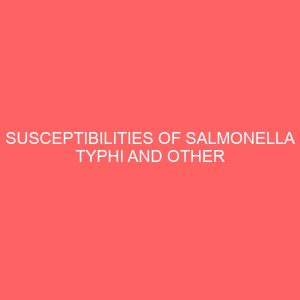Description
ABSTRACT
Avocado and watermelon has an excellent nutritional quality that can support the growth of microorganisms. Different media were formulated from both defatted and undefatted avocado pear and watermelon. The proximate analyses of the fruit flour shows that defatted samples were better in terms of minerals contents than their correspomding undefatted samples. Pseudomonas aeruginosa, Staphylococcus aureus and Escherichia coli in that order thrived very well in the composed media. The test bacteria grew better in media composed with defatted fruits than their corresponding undefatted samples. Undefatted samples seem to support fungal growth that defatted samples. Trichoderma sp. Grew better than Aspergillus flavous and Penicillium notatum. Comparing with the performance of conventional bacteriology and mycological media, avocado pear and watermelon are s good and cheap media material for the cultivation and isolation of both bacteria and fungi.
CHAPTER ONE
1.0INTRODUCTION
Watermelon originated in Africa and has been in cultivation for more than 4, 000 years in the drier parts of the continent and throughout India and parts of Asia. It is used as a dessert fruit and a thirst quencher and in the very dry parts of Africa, it is relished by both man and his animals as a source of water. Watermelon was widely distributed throughout the remainder of the world by African slaves and European colonists. It was carried to Brazil, the West Indies, Eastern North America, islands of the Pacific, New Zealand, and Australia. It has been cultivated in the Middle East for thousands of years. The plants have weak stems and climb by tendrils, which hang from tree as tall as 20 to 60 feet, the watermelon fruit ripens on the ground. There is no way of determining with certainty when watermelons are ripe, and harvesting is based on the experience of the growers. Some believe that when the fruit is thumbed and gives out a dull sound, it is mature. Other criteria are the colour of that part of the fruit that touches the ground, which takes a yellow tinge as maturity approaches. High quality watermelon should have a sugar content measured as soluble solid of 10 or more in the flesh near the center of the melon. Seeded watermelons have dark brown or black oval seeds, whereas seedless varieties may contain no seeds at all or only very small and thin, jellylike white seeds. The colour of the flesh varies from yellow, orange, pink, or red in most commercial varieties. The fruits are very juicy, with a moisture content of over 90. Moreover, watermelons high water content hydrates your body as against the caffeinated energy drinks that tend to dehydrate your body. Watermelon is rich in vitamin C, vitamin A, vitamin B, amino acid and also carotenoid lycopene. The red flesh of watermelon contains some vitamin A. Watermelon is rich in vitamin B that is primarily responsible for the production of energy in your body. Hence, consuming watermelon can boost your energy levels. Watermelon can be viewed as a more nutritious alternative to having energy drinks or supplements prior to exercise.
The sugar content of the watermelon varied greatly and was different in different parts of the fruit. The average sugar content of the center part was 8.86, and had the highest sugar content compared to other parts of the fruit. The sugar content of the stem part, omphalic part, sunlightside part and groundside part were 7.48, 7.44, 7.20, and 6.99, respectively. The sugar content of the groundside part was significantly lower than the sunlightside part. The sugar content of the stem end part and groundside part was significantly higher than the sunlight side part and ground side part5. This fruit is also free from cholesterol that elevates heart related problems hence preventing heart attacks.
Watermelon juice, as a beverage, is found almost exclusively as an overthecounter drink made by hand from the pink flesh of the watermelon fruit. While, in some cultures such as those of Mexico and India, such watermelon drinks are popular, in the United States and elsewhere, watermelon juice drinks are rare, with commercially available packaged watermelon juice drinks virtually unknown.
Watermelon juice is commonly consumed in Mexico and can be found in many American bars as a mixer for alcoholic beverages. Due to its low acidity and growing conditions, watermelon is regarded as a potentially hazardous food. According to the CDC, watermelon caused a Salmonella outbreak in 2002 and 2006, a Norovirus outbreak in 2005 and 2006, and a Campylobacter outbreak in 2006. Because of these pathogens, watermelon juice must be pasteurized prior to consumption. In the fruit juice industry, juice is typically pasteurized by high temperature short time HTST pasteurization. This process uses plate heat exchangers to heat the sample quickly at least 78C. Generally there is less information of watermelon juice during storage time . So the study during storage is important for harvesting and postharvest technology to improve quality and processing characteristics. Hence the present study is selected to determine the chemical properties pH, TSS, reducing sugar and to analyze the microbiological characteristics during storage time.
Persea americana, or the avocado, is believed to have originated in the state of Puebla, Mexico, though fossil evidence suggests similar species were much more widespread millions of years ago, occurring as far north as California at a time when the climate of that region was more hospitable to them.
The native, undomesticated variety is known as a criollo, and is small, with dark black skin, and contains a large seed. It probably coevolved with extinct megafauna. The oldest evidence of avocado use was found in a cave located in Coxcatln, Puebla, Mexico, that dates to around 10,000 BC. The avocado tree also has a long history of cultivation in Central and South America; a water jar shaped like an avocado, dating to AD 900, was discovered in the preIncan city of Chan Chan. The earliest known written account of the avocado in Europe is that of Martn Fernndez de Enciso circa 14701528 in 1519 in his book, Suma De Geographia Que Trata De Todas Las Partidas Y Provincias Del Mundo. The first written record in English of the use of the word avocado was by Hans Sloane in a 1696 index of Jamaican plants. The plant was introduced to Indonesia in 1750, Brazil in 1809, South Africa and Australia in the late 1800s, and the Levant in 1908.
The word avocado comes from the Spanish aguacate, which in turn comes from the Nahuatl word huacatl awakat, which goes back to the protoAztecan pa:wa which also meant avocado. Sometimes the Nahuatl word was used with the meaning testicle, probably because of the likeness between the fruit and the body part.
The modern English name is not etymologically related to the similarsounding Spanish word abogado, meaning lawyer as in advocate, but comes through an English rendering of the Spanish aguacate as avogato. The earliest known written use in English is attested from 1697 as avogato pear, a term which was later corrupted as alligator pear. Because the word avogato sounded like advocate, several languages reinterpreted it to have that meaning. French uses avocat, which also means lawyer, and advocateforms of the word appear in several Germanic languages, such as the now obsolete German AdvogatoBirne, the old Danish advokatpre today it is called avocado and the Dutch advocaatpeer.
1.1.BACKGROUND OF THE STUDY:
Microbiological media have no doubt played a major role in the cultivation of microorganisms. Media are very expensive particularly in resourcepoor nations including Nigeria. The need for the cultivation and propagation of microorganisms on locally available agricultural products becomes imperative.
Plant materials have been used to recover both fungi and bacteria from different samples sources. Groundnut Akinola et al., 2004, sorghum extracts Akinola et al., 1997, local food stuff waste, cassava whey, cereals, threeleaf yam, African oil bean, maize and beans among other agricultural products have been used as both mycological and bacteriological media.
A single medium cannot totally support the growth of all organisms, but organism thrives optimally in a medium that satisfies their minimal nutritional requirements. the use of dehydrated media has gained a global acceptance in both mycological and bacteriological laboratories.
Avocado pear and water melon are edible and highly nutritious fruits that is very common in the tropics. The sizes varies from only a few centimeters to 25cm in length. It consists as much as 30 digestible fat and appreciable vitamins. Once mature fruit is picked, it perishes quite quickly in the case of avocado unlike the watermelon that can last quite a long time.
To the best of our knowledge, there has not been any report on formulation of microbiological media using avocado pear and watermelon. This makes this work innovative. Information is available on the formulation of media using agricultural materials. It is also known that defatting has different effect on the growth of microorganisms. However, there is no information on growth assessment of both fungi and bacteria of media containing avocado in any form. This study is aimed at providing this information.
1.2.AIMS AND OBJECTIVE:
This project work is aimed at achieving the following;
1.To assess the growth of both fungi and bacteria of media containing avocado and watermelon.
2.To provide knowledge and prove on formulation of microbiological media using avocado and watermelon.
3.To assess the microbial content of watermelon and avocado pear.
4.To promote the need for the cultivation and propagation of microorganisms on locally available agricultural products
1.3.SIGNIFICANCE OF THE STUDY:
The study seeks to improve the general knowledge of the watermelon and avocado pear microbial content. It is expected that at the end of this research work that the need for the cultivation and propagation of microorganisms on locally available agricultural products as well as the growth of both fungi and bacteria of media containing avocado and watermelon will be known.
1.4.LIMITATION OF THE STUDY:
As at the time of this research, the researchers main aim was to evaluate and formulate a media for the dehydration of microbiological media from avocado and watermelon.








Reviews
There are no reviews yet.